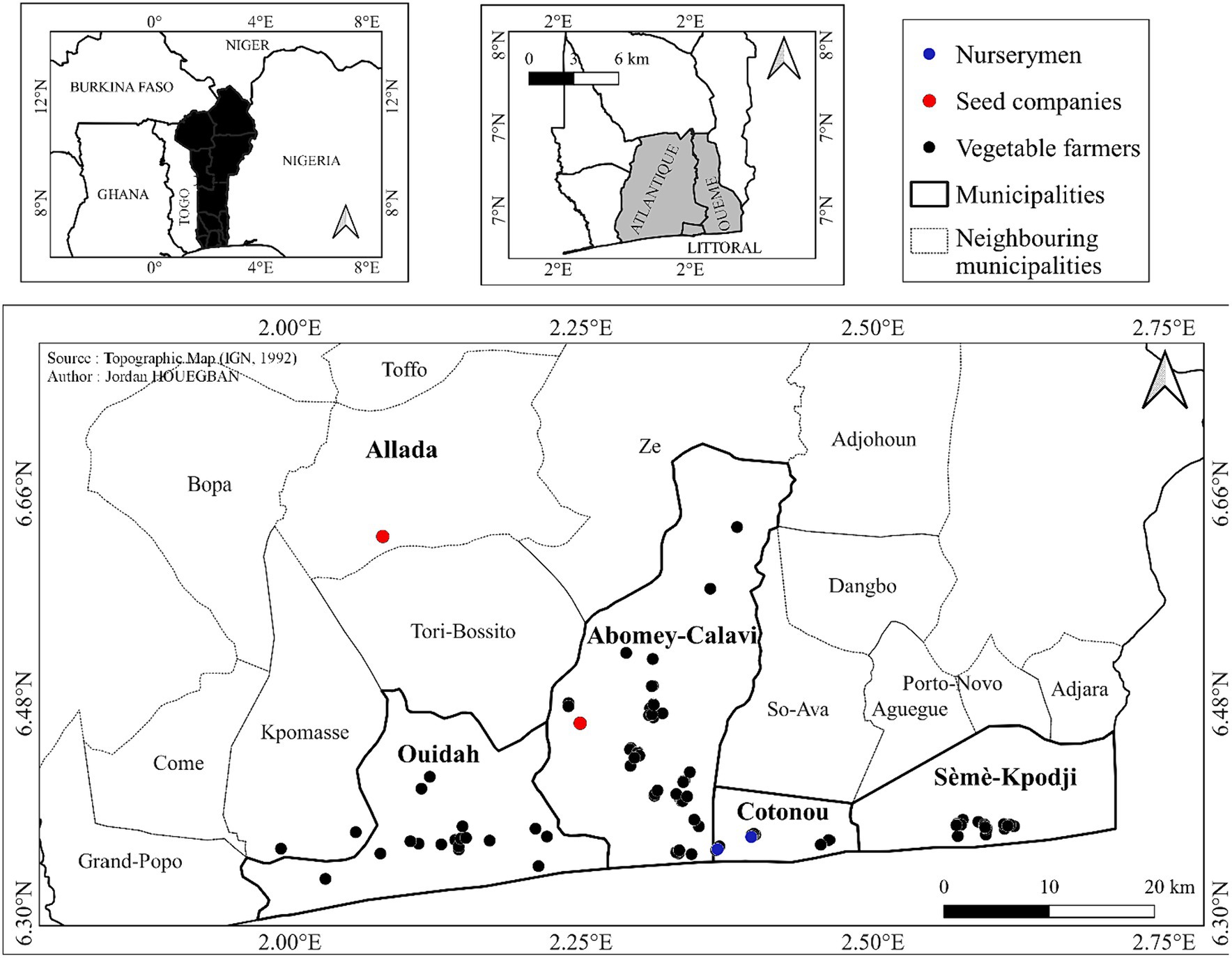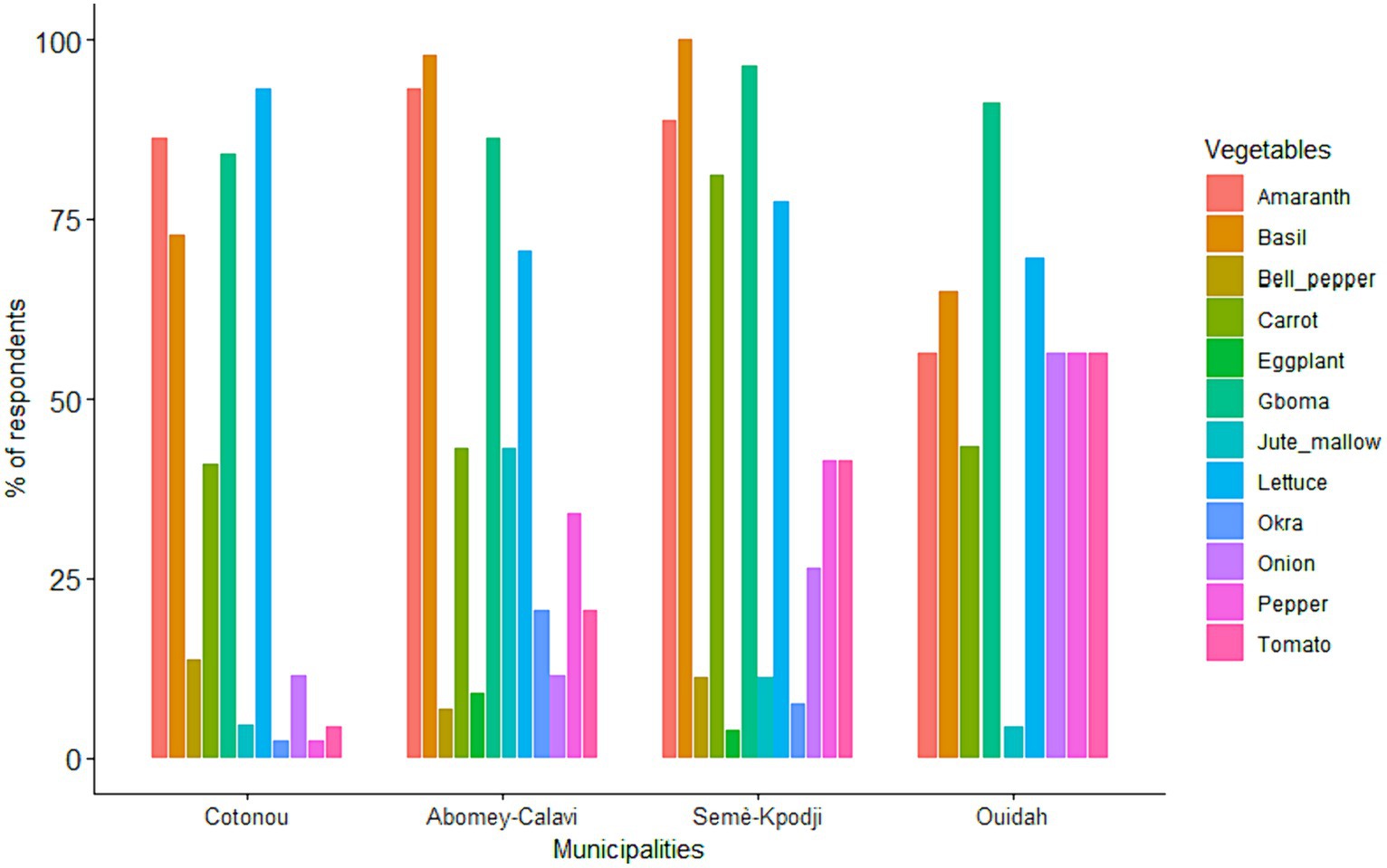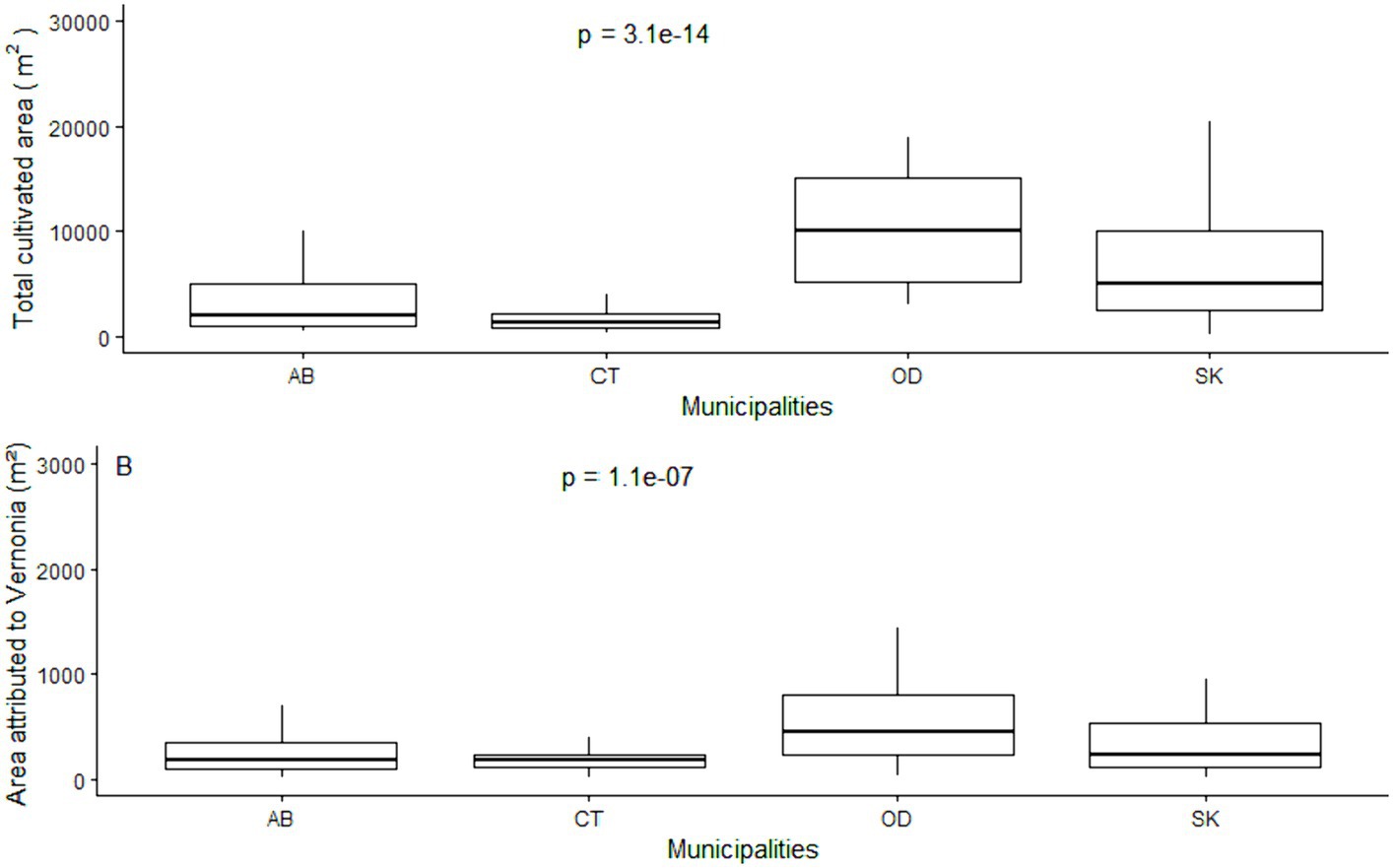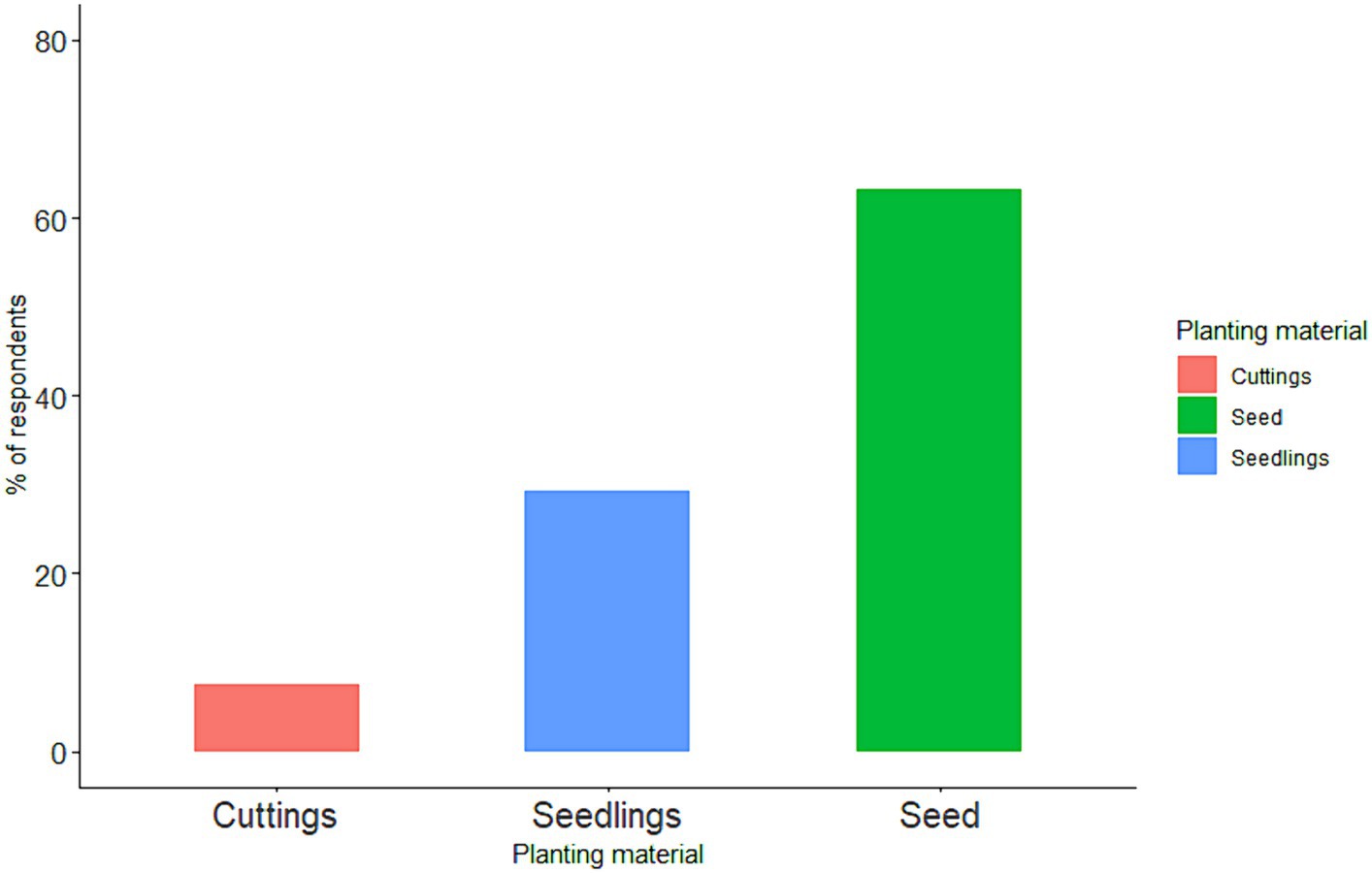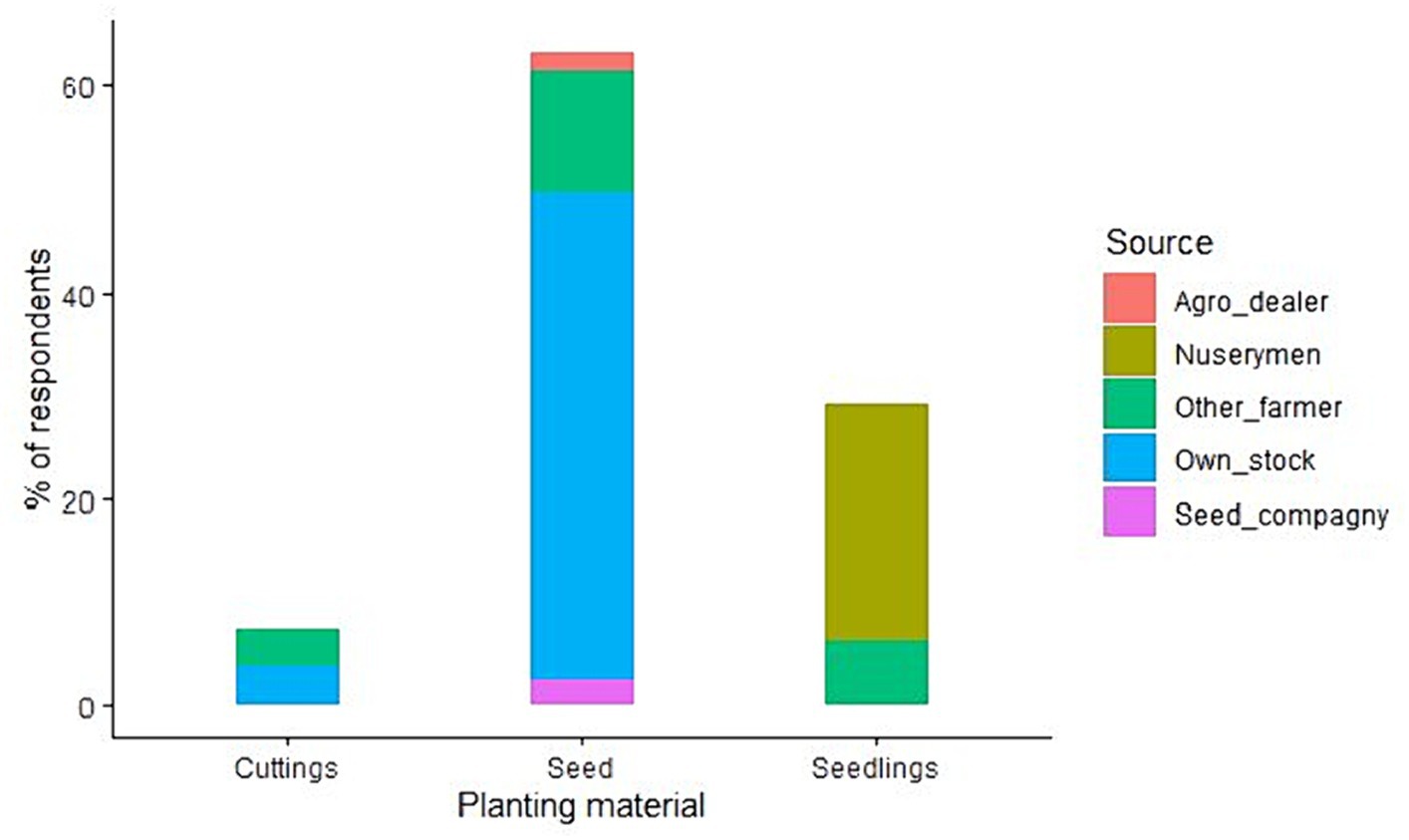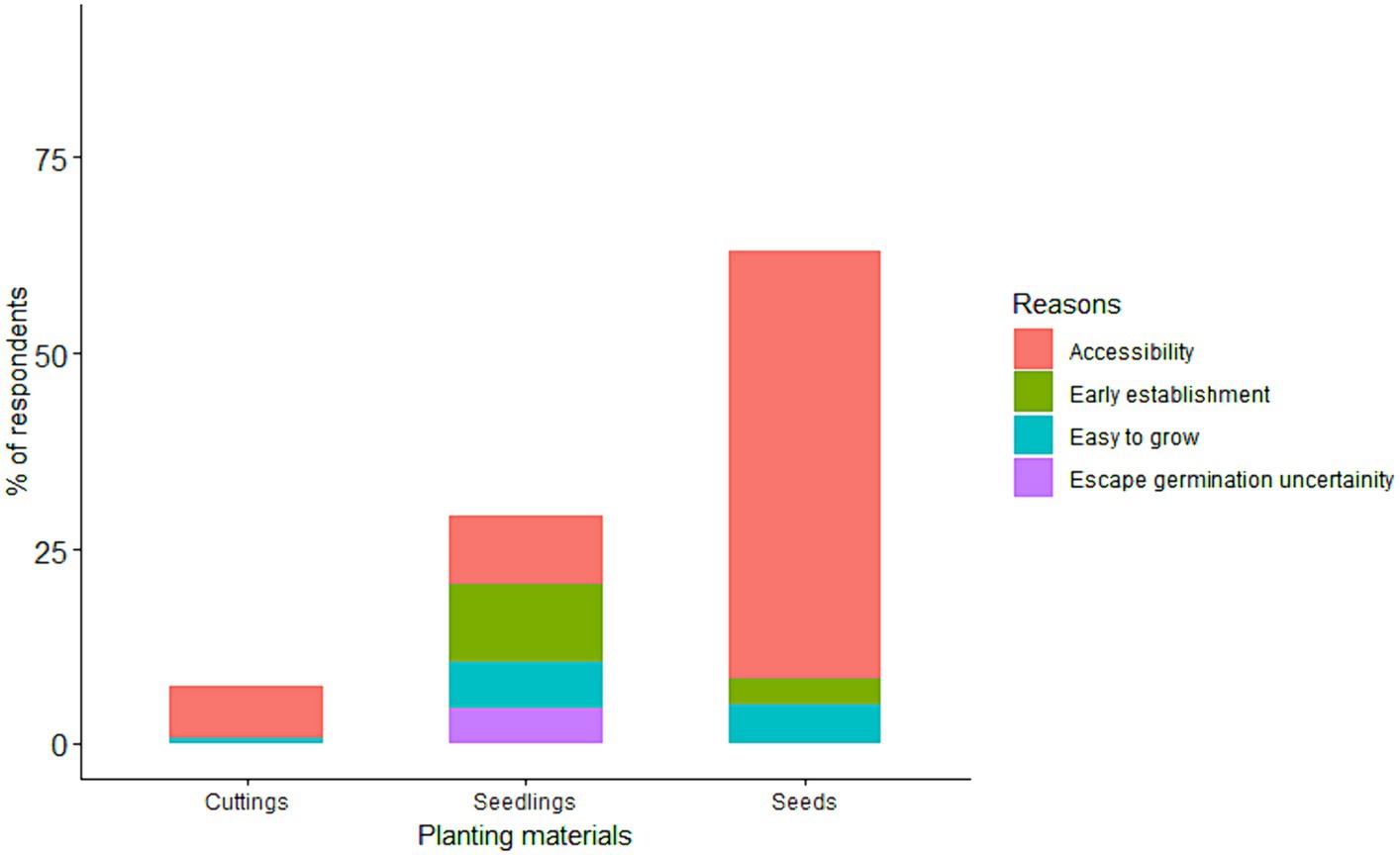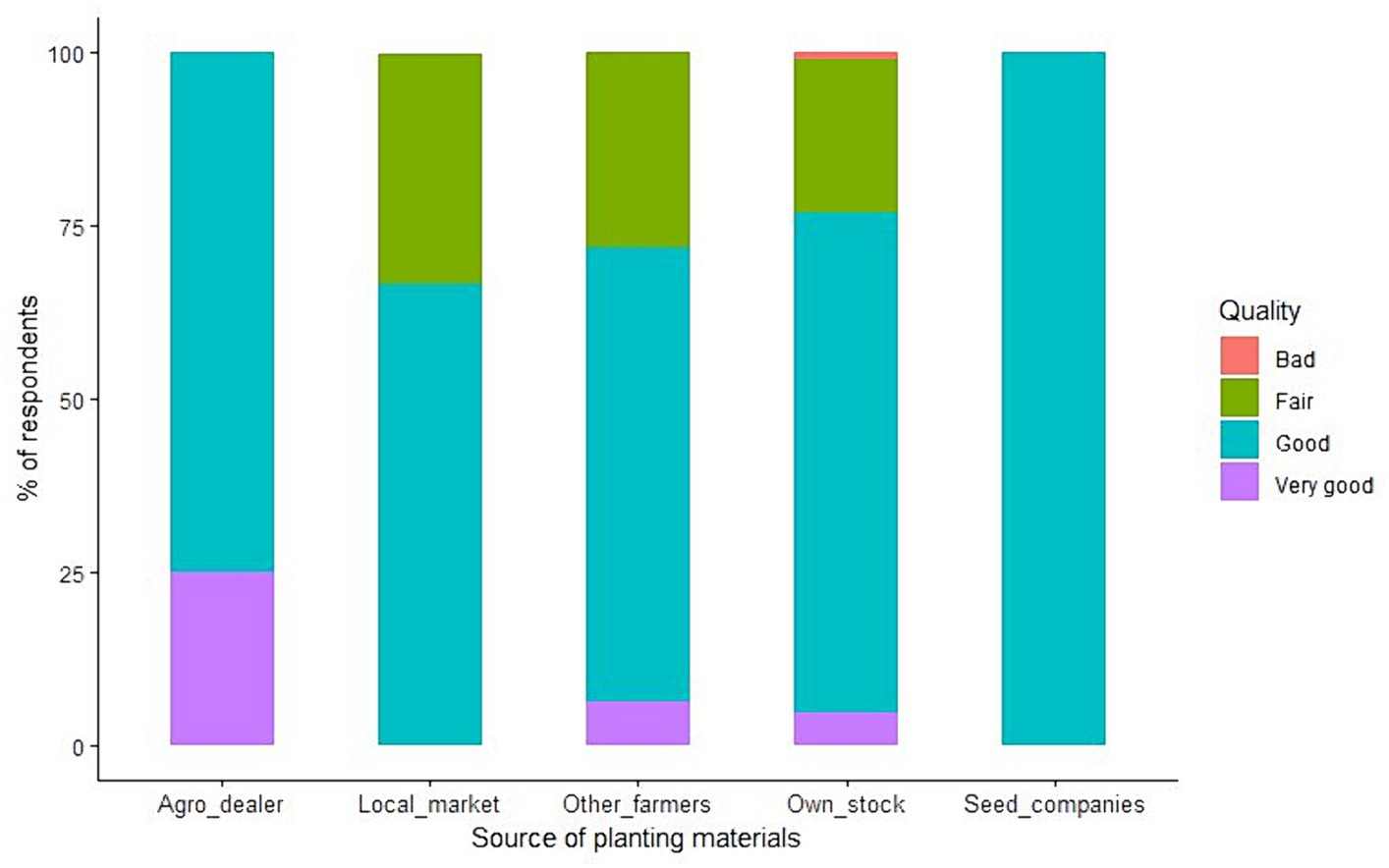Traditional African vegetables’ seed access and management practices: case of Vernonia amygdalina (Delile) in southern Benin
- 1Genetics, Biotechnology and Seed Science Unit (GBioS), Laboratory of Plant Production, Physiology and Plant Breeding (PAGEV), School of Plant Sciences, University of Abomey-Calavi, Abomey-Calavi, Benin
- 2West Africa Centre for Crop Improvement (WACCI), College of Basic and Applied Sciences, University of Ghana, Legon, Ghana
- 3World Vegetable Center, West and Central Africa Coastal and Humid Regions, Cotonou, Benin
- 4Ecole d’Horticulture et d’Aménagement des Espaces Verts, Université Nationale d’Agriculture, Kétou, Benin
- 5World Vegetable Center, Eastern and Southern Africa, Arusha, Tanzania
- 6Department of Crop Science, College of Basic and Applied Sciences, University of Ghana, Legon, Ghana
Vernonia amygdalina is an African traditional leafy vegetable which is a source of income for many households involved in its production in West and Central Africa. The species possesses several medicinal and nutritional properties. Despite its importance, there is limited information on farmers’ access to seed, seed production practices, seed trade, and related constraints. This research aimed at investigating farmers’ seed access and management practices. A non-probabilistic snowball method was used to sample and interview 164 bitter leaf seed sector actors from urban and peri-urban areas in Benin. Results indicated that vegetable farming is mainly practiced by men and it was the main occupation for 94.47% of the farmers interviewed. A significant association was found between the location and farmers’ experience (p-value = 0.01358). A diversity of Vernonia amygdalina morphotypes were found. Sixty-three percent of the farmers surveyed use seeds as planting material, 29% use purchased seedlings and only 7% use stem cuttings for Vernonia amygdalina production. Most of the seeds used (74%) were from farmer-saved seeds, harvested from isolated plants during production. The main constraints to V. amygdalina production reported by farmers were the unavailability of seeds (41% of respondents), low germination percentage (18%) and low seed longevity (12%). Findings from this study can inform solutions to improve farmers’ access to high-quality seeds and enhance V. amygdalina vegetable production.
1 Introduction
African bitter leaf, Vernonia amygdalina Delile (synonym: Gymnanthemum amygdalinum Delile), is a popular vegetable in West and Central Africa (Abosi and Raseroka, 2003). It is native to the tropical regions, and belongs to the Asteraceae family (Tekou et al., 2018). The genus Vernonia is the largest of the tribe Vernonieae with circa 1,000 species (Sterling and Samuel, 2016). More than 300 species have been described from Africa with about one-third occurring in Madagascar. Vernonia amygdalina grows as wild in most countries of tropical Africa, from East-Guinea to Somalia and south to north-eastern South Africa, and in Yemen. It is commonly grown as a vegetable in Benin, Nigeria, Cameroon, Gabon and the Democratic Republic of Congo, and to a lesser extent in their neighbouring countries.
Vernonia amygdalina grows naturally on riversides and lakes, in forest margins, woodland and grassland, where the average rainfall is 750-2,000 mm and up to 2,800 m altitudes. Vernonia amygdalina is referred to as Awonwono in Ghana, Ndolè in Cameroon, Onugbu in Nigeria or Aloman in Benin (Yineger and Yewhalaw, 2007; Dansi et al., 2009; Farombi and Owoeye, 2011; Moshi et al., 2012; Komlaga et al., 2015; Kiguba et al., 2016). The species is drought-tolerant however, humid and humus-rich soils are recommended for adequate growth (Kaur et al., 2018). The plant can reach 10 m tall. Unlike the bark which is brown or grey, the leaves are green and measure on average 10-15 cm long and 4-5 cm large. The petiole is 1-2 cm long and can be qualified as short. The plant blooms and produces seeds approximately six months after sowing. The creamy white flowers are bisexual, grouped in dense heads, and form flat clusters that can measure 15 cm in diameter. They look like thistles and measure 10 mm long (Ofori et al., 2000). From the literature, Vernonia amygdalina is propagated through stem cuttings and seed, but the use of seed for propagation is poorly documented (Malav et al., 2020). It is a traditional leafy vegetable, consumed for its therapeutic properties and nutritional value. Like many green leafy vegetables, its consumption is believed to prevent, protect and cure certain diseases such as malaria, tuberculosis, and intestinal worms (Farombi and Owoeye, 2011). In industrialized countries, bitter leaf is used for the fortification of some common foods (Aliyu and Morufu, 2006). In Africa, it is a traditional anti-diabetic medicinal plant used to cure or manage many diseases in multi-drug therapy (Atangwho et al., 2013). The nutritional composition of Vernonia amygdalina leaves per 100 grams of edible portion is: 5.2 g proteins, 10.0 g carbohydrate, 145 mg calcium, 0.7 mg phosphorus, 5.0 mg iron, 85.0 mg zinc, 710.0 mg manganese, 5.1 mg ascorbic acid (Shewo and Girma, 2017). The species is richer in protein and carbohydrate compared to value reported in other traditional vegetables like Amaranthus and Solanum macrocarpon (Oboh et al., 2005; Asaolu et al., 2012). Study of Oboh (2006), revealed that Vernonia amygdalina leaves contain phytate (1015.4 mg/100 g), cyanide (l.l mg/kg) and tannin (0.6%). In Benin, 90% of the 10,600 tons of the total leafy vegetable production recorded in 1990 was dominated by only four species including Vernonia amygdalina (Colin and Heyd, 1991). A survey conducted in Benin (Dansi et al., 2008) ranked Vernonia amygdalina as the 4th most important vegetable in the market out of 24 species recorded. According to Martial et al. (2019), Vernonia amygdalina, is produced once a year and have 5 crops per production cycle and the production cost of a vegetable plot varies from 500 to 1,000 FCFA in the rainy season and is above 1,000 FCFA in the dry season.
Although V. amygdalina is the most prominently studied Asteraceae vegetable species in Africa (Alabi and Adeyemi, 2021), most of these studies focus on its ethnoveterinary, ethnomedicinal, protective effects on crops and bioactive properties. Reliable data on the production and cultivated area of V. amygdalina is scanty, as compared to other traditional African vegetables (Okeno et al., 2003). To date, V. amygdalina is still poorly documented. There is no information on the farmers’ seed access, seed production practices, seed trade and distribution chains and related constraints.
Diet diversification through increased production and consumption of traditional vegetables is a good way to improve nutrition and food security in Africa. Generally, farmers have access to crop seeds from different sources including formal, semi-formal and informal sources. Understanding seed systems helps to design appropriate strategies to improve access to quality seeds, seed production, conservation and distribution. The primary aim of this research is to document the V. amygdalina crop management strategies used by local communities and identifying the key challenges.
2 Materials and methods
2.1 Study area
In Benin V. amygdalina is commonly cultivated in urban areas by market gardeners (Agossou et al., 2018). Five sites in urban and peri-urban areas in southern Benin were selected and surveyed based on their importance of V. amygdalina production (Adifon et al., 2015). Vegetable production sites located at Cotonou were classified as urban, while those located within Abomey-Calavi, Ouidah, and Sèmè-Kpodji were classified as peri-urban vegetable production sites (Pasquini et al., 2009). The study sites fall in the Guineo-congolian agroecological zone of Benin (Adomou et al., 2006). The climate is sub-equatorial with two rain seasons (April to July and September to November) and two dry seasons (December to March, and August). The rainfall varies between 900 and 1,200 mm, while the average temperature is about 27°C (Yetein et al., 2013). The soils are mostly sandy in Cotonou, ferralitic in Ouidah, and hydromorphic with some elements of tropical ferruginous soils in Semè-kpodji. Most of the territory of Abomey Calavi is dominated by tropical ferralitic soils and sandy soils (Nacoulma and Guigma, 2015).
2.2 Respondents sampling
The non-probabilistic snowball sampling method was used to sample 164 respondents. The method yields a study sample through referrals made among people who share or know of others who possess some knowledge that is of research interest (Wright and Stein, 2004). On each production site, the sample size was obtained based on information saturation. Data saturation was considered reached when new respondents did not provide additional information (Guest et al., 2006; Mason, 2010). Vegetable farmers in the study areas are organized into cooperatives. The contacts of the presidents of vegetable farmers’ cooperatives, as well as representatives of seed companies in each study site, were obtained from the Territorial Agricultural Development Agency (ATDA) or their local representatives. For the vegetable farmers, initial meetings were organized with the presidents to select only the cooperatives that grow V. amygdalina. Through consultation with farmers and extension agents, seed companies that had V. amygdalina in their portfolio and nurserymen producing V. amygdalina seedlings for sale were identified.
2.3 Data collection
Questionnaire-based semi-structured interviews were conducted with the individual respondents. Three different questionnaires were designed and used to interview three different categories of respondents: vegetable farmers; seed and seedling producers and seed traders. Data collected were related to the farmer’s sociodemographic characteristics (name, gender, age, level of schooling, location and experience in vegetables production); V. amygdalina propagation methods and production (seeds, seedlings or cuttings); type of planting materials used and their sources (Own stock, seed company, nurserymen, agro dealer, neighbouring farmers); seed production and post-harvest practices (storage duration and condition); seed conservation and distribution methods; and constraints faced by the different actors in their activities. Regarding the source of seeds used for production, farmers were asked to describe the quality of the seeds by classifying them into four germination categories: Bad <30%; Fair 30 – 49%; Good 50 – 80% and very good ˃ 80%. The questionnaires were delivered through the Survey software KOBO toolbox.
KOBO toolbox survey software is a data collection, management, and visualization platform used globally for research and social good. In the framework of our survey, it has been used for data collection.
2.4 Data analysis
Descriptive statistics were used to characterize the survey respondents and assess general trends in farmer responses. ANOVA test was used to compare means of quantitative variables and Fisher exact tests were used to assess the association between farmers’ location and their experience; location and the type of planting materials used; planting materials and their sources; planting materials used and farmers experiences; planting materials and farmers’ educational level. Data were analyzed in R software version 4.2.10 (R Core Team, 2022).
3 Results
3.1 Structure of Vernonia production sites
The respondents from Cotonou are farmers cooperatives using public domains like Houéyiho, PLM Aledjo, and OPT located between latitudes 6°35 and 6°36 and longitudes 2°36 and 2°46. Respondents in Seme-kpodji belong to VIMAS, Chaine de Valeurs, CEMAG and COGEMAS cooperatives, located between latitudes 6°37 and 6°38 and longitudes 2°57 and 2°61. These cooperatives lead the production of traditional and exotic vegetables and supply fresh vegetables to urban areas. Two Vernonia seedling producers (nurserymen) were surveyed in Cotonou. The first seed production and distribution company was surveyed in Abomey-Calavi (“Jardin pour Tous”). Only the production site of the second seed company (“Seed Services Cooperative”) was located in Allada, out of the study surveyed area (Figure 1).
3.2 Socio-demographic characteristics of respondents
Table 1 presents the socio-demographic characteristics of the respondents. Overall, Vernonia gardening is mainly practiced by men (> 85%) (p < 0.0001). More than 75% of the farmers were between the age of 30 and 60 years with an average age of 40.7 ± 11.5 years. More than 80% of the farmers attended primary school. Farming is the main activity for 94.47% of respondents. A significant association was found between the location and farmers’ experience (p = 0.01358). Farmers in Cotonou had on average 16.2 ± 12.4 years of gardening experience which is higher than the overall average (12.3 ± 9.4 years).
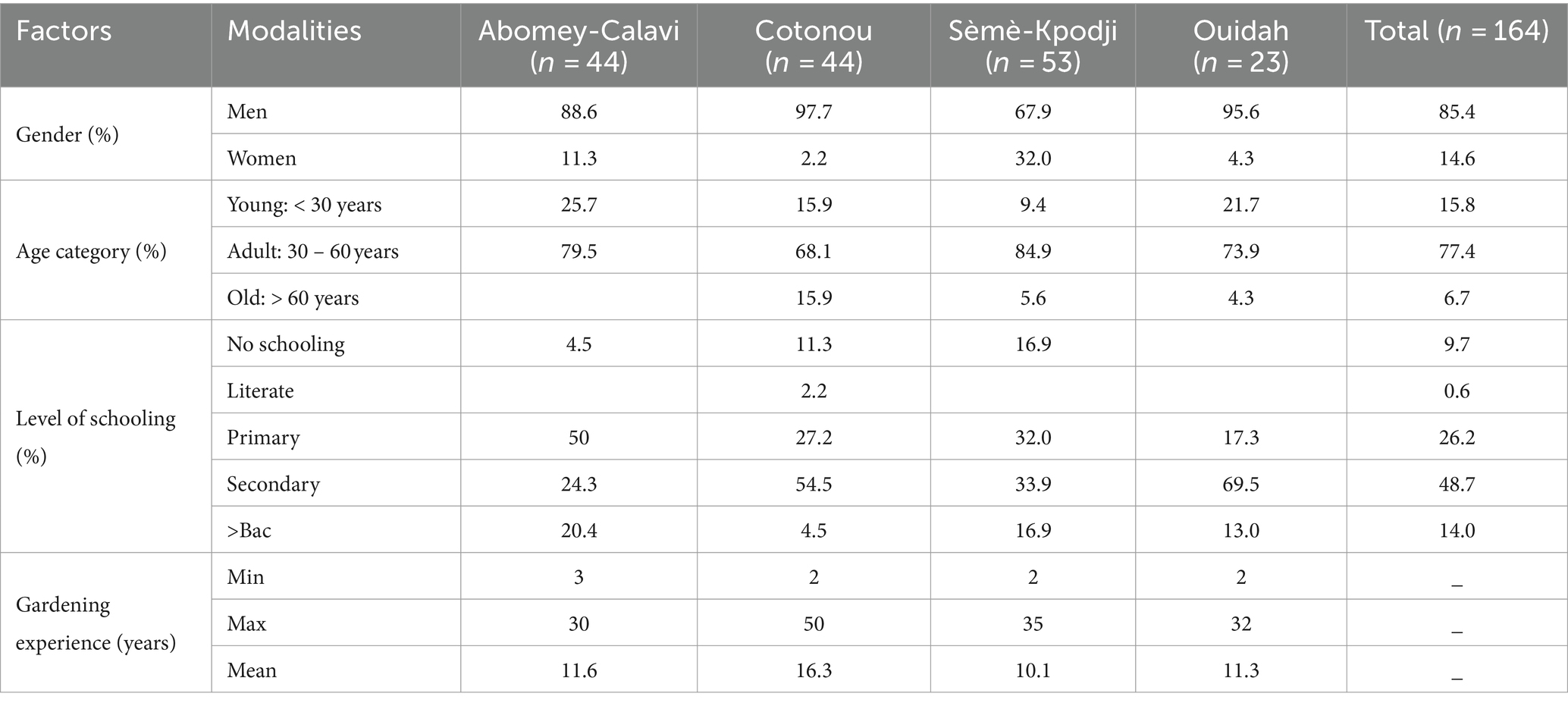
Table 1. Characteristics of respondents surveyed in Abomey-Calavi, Cotonou, Sèmè-Kpodji, and Ouidah municipalities.
3.3 Diversity of other vegetables produced
In the surveyed areas, Amaranthus (Amaranthus spp.), Basil (Occimum gratissimum), and Gboma (Solanum macrocarpon) were the most frequently cultivated species based on the number of growers. These three traditional African vegetable species were closely followed by lettuce (Lactuca sativa). A significant association was found between the location and the type of vegetables produced (p < 0.0001). In Cotonou, lettuce is one of the most commonly produced vegetables, while there are very few respondents engaged in the production of tomato, okra and peppers. Respondents from Ouidah mainly grew tomatoes and peppers (Figure 2). More than 80% of respondents produced carrots (Daucus carota) in Seme-Kpodji, while only 40% of farmers surveyed in Cotonou produced it.
3.4 Relative importance of land allocation for Vernonia production
The total area under vegetable cultivation (A) and land allocated for V. amygdalina (B) varied significantly (p < 0.0001) among farmers across municipalities (Figure 3). Farmers in Cotonou had less area under vegetable cultivation than farmers in other municipalities. This can be justified by the fact that Cotonou, the economic capital of the Benin Republic, is highly urbanized leaving little space for urban agriculture. Farmers in the municipalities of Ouidah and Semè-Kpodji had the largest land allocated to vegetable production. These two cities are peri-urban sites and a priori had relatively lower land pressure compared to Cotonou.
3.5 Farmers’ awareness of Vernonia morphotypes
Several Vernonia morphotypes were described by farmers (Figure 4). Farmers generally classified morphotypes into two categories using phenotypic and organoleptic criteria. Those referred to as “improved” varieties have larger leaves and have less bitter taste (Amelioré, Glazoué) while those called “local” varieties have small leaves with a pronounced bitter taste (Gouton, Local), each category comprising several types. According to the respondents only the “local” variety “Gouton” gives cuttings with a good recovery rate after plantation. In urban and peri-urban areas, varieties with a slightly bitter taste and large leaves are the most preferred by consumers. The varieties with small leaves and bitter taste are mostly used for medicinal purposes.
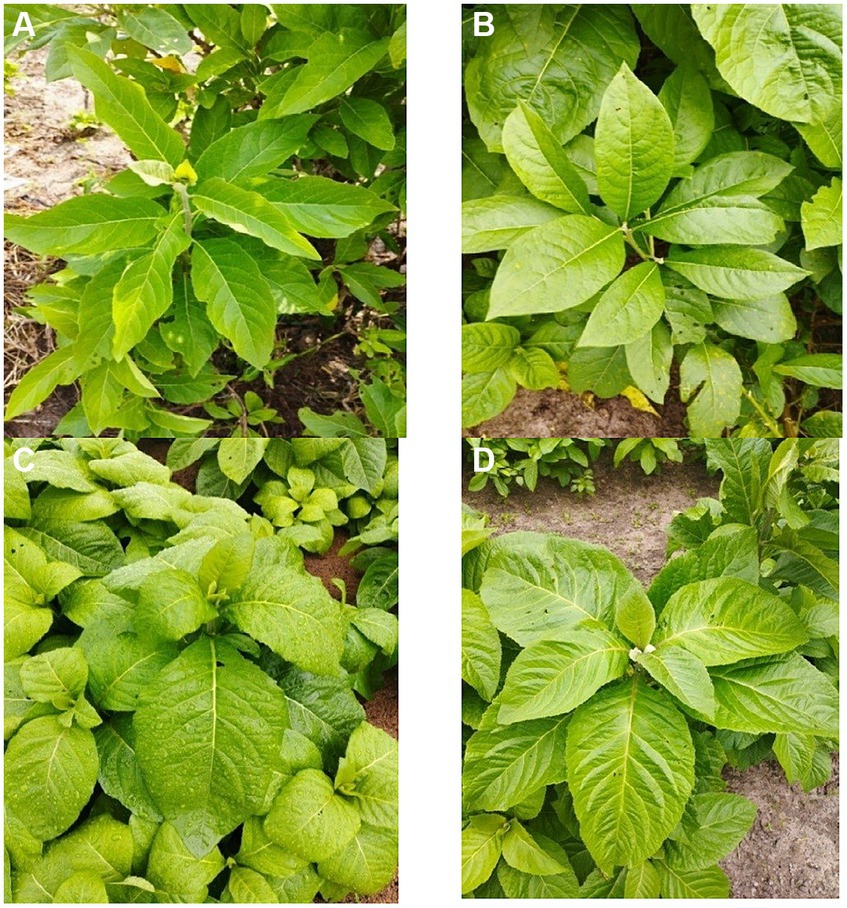
Figure 4. Different varieties of Vernonia amygdalina grown by farmers. A,B are called “Local” varieties while C,D are called “Improved” varieties.
3.6 Planting materials used by farmers
3.6.1 Type and source of planting materials
Sixty-three percent of the farmers surveyed used seeds as planting material against 29 and 7% of respondents using seedlings from commercial nurseries and stem cuttings, respectively, for V. amygdalina production (Figure 5).
Most of the seeds used (74%) were from farmers’ saved seeds (Figure 6), harvested from isolated plants. Only 3 % of the farmers surveyed buy seeds from seed companies while 18 % of them obtained their seeds from neighbouring farmers. When purchased, seedlings were mostly supplied by nurserymen (78%). Farmers also purchased seedlings from other farmers who have a surplus of seedlings (21%). The stem cuttings were either from the farmers’ stock or from neighbouring farmers. There was a significant association between the type of planting materials used and their sources (p < 0.0001). However, there was no significant association between the type of planting material used and farm experience (p = 0.30). Also, the type of planting material used did not significantly depend on the farmers’ education level (p = 0.22).
The exchange between neighbouring farmers represents a significant strategy to access the different planting materials.
3.6.2 Rationale for farmers’ choice of planting materials
Several reasons explain the respondents’ choice of the type of planting materials used (Figure 7). These reasons included the physical accessibility, ease of use, early maturity, avoidance of the risk of poor germination and time-saving. The physical accessibility of the seeds was the main reason why farmers mostly used their own-saved seeds. Farmers intentionally kept some plants for seed production from which they do not harvest leaves. There were no clear criteria for the selection of seeds for the nursery. Due to the small size and light weight of the seeds, they are dried in jute bags and sown on the irrigated nursery beds. The seed beds are covered with straw or nets. Farmers using the seedlings did it to avoid the risk associated with low germination rate of seeds and to save time by direct transplanting of the seedlings bought from nurserymen. The seedlings to be transplanted were selected based on their vigour and stem girth.
3.7 Farmers’ perception on Vernonia amygdalina seed quality
Seventy percent of seeds obtained from farmers’ own stock were qualified as good quality and 22% as of a fair quality (Figure 8). For seeds sourced from other farmers, 65% were described as good quality while 28% qualified as fair quality. Very few farmers sourced seeds from agro-dealers (3%) and seed companies (4%) although these were described as sources for good quality seed (100%) (see Figure 9).
The criteria taken into account by farmers when assessing the quality of a seed lot were also investigated and two broad categories emerged. These were seed-related criteria (germination rate, vigor and purity) and seed label criteria (packaging and source).
Sixty percent of farmers reported the germination rate as the most important criterion for assessing the quality of a seed lot followed by seed vigor (25%) and then purity (7%). The origin of seeds as well as their packaging were reported by only 2% of the respondents as the criteria used to assess seed quality.
3.8 Production challenges
Although seed is the main planting material used by farmers, accessibility to quality seed is lower during the rainy season (41%) (Figure 10). According to farmers, the plants flower twice a year: once in the dry season (November – February) and once in the rainy season (May – July). However, the seeds obtained in the rainy season have a low germination rate. Therefore, only seeds produced in the dry season were considered of good quality. Low germination percentage and low storage capacity of the seeds were reported by 18 and 12% of the respondents, respectively.
4 Discussion
4.1 Socio-demographic characteristics and vegetable production
The results showed that the majority of urban and peri-urban bitter leaf farmers were male, representing 85% of the respondents. These results are consistent with those of Sotondji et al. (2019), who found that urban and peri-urban vegetable production in southern Benin is essentially male-dominated. Although in reality many of the production activities are carried out by women (Patra et al., 2018), their role is often seen as helpers. As a result women are not part of the decision-making process (Adom et al., 2021). Eighty-nine percent of the respondents had minimum attended primary school, meaning that they could read and write in French. Since literacy is considered a key factor in the adoption and application of innovations in rural areas (Biaou et al., 2016), farmers in the study area are more likely to be informed of new agricultural innovations. The Fisher test showed a certain specialization of production according to the production zones. The specialization of vegetable crops according to production zones had been confirmed by Diogo and Tama (2019). However, regardless of the production zones, amaranth, basil, and gboma were the most frequently cultivated African indigenous vegetables species. Similar results were reported by Assogba-Komlan et al. (2007) who indicated amaranth, bitter leaf and gboma as among the most popular vegetables in Benin. Our results also confirm Pasquini et al. (2009) prior classification of these vegetables as among the important African indigenous vegetables grown in urban and peri-urban areas in Benin.
4.2 Planting materials, their sources, and related constraints
Our study revealed that seed is the most used planting material to establish Vernonia production. These findings are contrary to the findings by Colin and Heyd (1991) in southern Benin and reported by Adebooye et al. (2005) and Shankari et al. (2018), who found that cuttings were the most used planting materials by farmers in Nigeria and Malaysia, respectively. While the use of seeds or cuttings as planting materials would be context specific, the use of seed as planting material is poorly documented. This may explain why the literature on seed use is inconsistent. Vernonia amygdalina can be multiply using seeds, seedlings or cuttings. Utilization of seeds as planting materials has many advantages. Seed are easy to plant, cheap, easy to handle and can be stored for a long period of time than cuttings. However, seeds require proper land preparation, take a long time to establish and often lead to genetic variation and the phenotypic expression in offsprings. In our study the physical accessibility of seed and ease of use were reported by farmers as advantageous while low germination was reported as a disadvantage. To deal with the germination uncertainty some farmers purchase seedlings from commercial nurseries. The scarcity of commercial nurseries along with the high cost of seedlings can be considered as disadvantages. Accessibility and early maturity are some key advantages reported for the use of stem cuttings. However, sometimes leaves of Vernonia produced from cuttings are of smaller size compared with plants grown from seeds (personal observation, corroborated with farmers’ declarations). The seeds used by the surveyed farmers were obtained from the informal sector, mainly from their own-seed stock. This is a characteristic of traditional African vegetable seed systems (Ayenan et al., 2021). According to Kansiime et al. (2018), the majority of farmers obtain their seeds from the informal sector, dominated by seeds from farmers’ own stock and from their neighbours. Only a few farmers obtain their seeds from the formal sector. Several reasons were given by farmers to justify their choice of seed supply sources. The immediate accessibility of seeds at the time of planting is one of the major reasons.
The use of seeds from sources other than the producer’s own seed is made when the farmer lacks seed due to poor harvest or due to loss from pests and diseases. Supply from formal sources can only be done when seeds are available in formal distribution channels. Among the factors that may enhance the purchase of seeds from the formal system are the availability of new varieties that perform better than farmers’ varieties. In the study area, only two seed enterprises had V. amygdalina in their crop portfolio. Formal vegetable seed production is nascent in Benin but will require more efforts from all the stakeholders involved to sustain it. The available seeds were not improved varieties since no breeding program had been initiated on the species. In this context, the use of farmers’ knowledge of the different morphotypes available and farmers’ desired traits could be a good asset for the implementation of a breeding program.
Seed systems for traditional vegetables are not yet robust (Chweya and Eyzaguirre, 1999) and vegetable farmers do not have the capacity to produce high-quality seeds. According to Croft et al. (2018) and Pincus et al. (2018), the informal sector is then positioned as the first source of seed supply for traditional vegetables. This system is characterized by individual farmers who use seeds saved from past harvests for the next production. They share seeds with neighbours or other farmers in the same community and purchase seeds from the local markets (Mulesa et al., 2021). In Kenya, the informal seed system is the main source of seeds for traditional crops (Munyi and De Jonge, 2015). Approximately 80% of smallholder farmers rely on the informal system for their seeds (Biemond et al., 2013). However, the genetic purity, germination, and phytosanitary status of seeds in the informal system are highly inconsistent (Keatinge et al., 2015; Pincus et al., 2018).
The formal seed sector only distributes seeds of crops with high market value, which are mostly exotic species. Several reasons can also justify the reluctance of seed companies to invest in the production of traditional vegetable seeds. These include fragmented market, a perceived low-profit margin, unfavourable legislation and a low seed replacement rate by farmers (Minot, 2008). In Benin, constraints affecting the development of vegetable seed systems include the low availability of specialized human resources in vegetable breeding in the public and private sectors and seed inspection at the Directorate of Plant Production (DPV) and at the Departmental Directorates of Agriculture, Livestock and Fisheries (DDAEP). Other constraints include the lack of investment in vegetable breeding by the public and private sectors; long duration (about two years) for variety registration and release; lack of information on the cost for variety release and registration in the Beninese Catalog of Species and Varieties (CaBeV); delay in seed certification due to the centralization of the process and the lack of resources (financial, materials, inspectors) of DPV and DDAEP; and an inefficient seed distribution network of the formal sector that only covers part of the country (Ayenan et al., 2022).
Twenty-nine percent (29%) of farmers buy seedlings from nurserymen as planting material. This was justified by the fact that seedlings have the advantage of being ready for immediate transplanting, which reduces production time, but also farmers have the opportunity to choose only robust and vigorous seedlings which ensure better growth and productivity. However, commercial nurseries are still underdeveloped and require investments and promotion, in order to meet the demand. The low quality of seeds, which results in a low germination rate, is one of the constraints encountered by farmers in the use of seeds as planting material. However, findings from studies on this subject seem to be conflicting. Malav et al. (2020) collected seeds from three-year-old plants, separated them with the floatation method, sown them in petri dishes in a dark environment at 25°C ± 2 and reported no-germination. However, Okafor et al. (1996) reported a germination rate of 89% for V. amygdalina seeds sown without any pre-germination treatment. Similarly, some of the farmers surveyed (8,13%) did not report poor seed germination as a constraint. This may be because farmers do not record any data on seed germination and because of the small seed size, they used lots of seeds to compensate for the low germination percentage. Seed storage conditions can also affect their germination. Farmers store seed in plastic bags or jute bags for a period up to 6 months. Since they do not have access to cold chamber facilities, they store the seed lots in a cool and dry place. However, farmers attributed the low germination to the fact that seeds were subjected to heavy rainfall which caused mold. This has been reported that the environmental factors (temperatures and relative humidity) during seed maturation in the field can significantly affect the quality of seed produced (Balducchi, 1987; Zhou et al., 2020).
Several other factors, both internal and external influence the germination process. The genotype, the physiological immaturity and the dormancy are among the factors that influence the germination of the seeds. Determining the best conditions for germination is therefore important for this species (K’Opondo et al., 2011).
5 Conclusion
This study documented the seeds access, management practices and related constraints of one of the most consumed traditional African vegetables in West and Central Africa. We found that a diversity of morphotypes of Vernonia amygdalina are grown by farmers. Also, seed is mainly sourced from the informal system, and is the most common planting material used by farmers. The temporal unavailability of seeds, followed by low germination percentage and low seed longevity were the main constraints to the production of the species. The prevalence of seeds as the predominant planting material, despite the associated challenges, hints at a potential knowledge gap concerning vegetative propagation techniques for Vernonia amygdalina. Vegetative propagation often demands specialized skills that might not be well-known to all farmers. Additionally, Vernonia is a cross-pollinated plant, the propagation through seeds can offer a valuable source of genetic diversity, which could be advantageous for adapting to varying environmental conditions. This inherent potential for genetic diversity may well contribute to the perceived advantages of seed propagation over vegetative methods. Considering the importance of neglected and underutilized species for local communities, it is important to develop crop improvement and genetic resource conservation programs to enhance their use. The promotion of an integrated seed system is recommended and requires training and capacity building of Vernonia seed producers, as well as the establishment of an effective quality control system that would allow for the commercialization of seeds with minimum certification requirements (Quality declared seeds). Similar systems already exist and are functional with other traditional African vegetables such as amaranths, African nightshade, African eggplant and spider plant.
Data availability statement
The raw data supporting the conclusions of this article will be made available by the authors, without undue reservation.
Ethics statement
Ethical review and approval was not required for the study on human participants in accordance with the local legislation and institutional requirements. Written informed consent from the participants was not required to participate in this study in accordance with the national legislation and the institutional requirements.
Author contributions
JH: Conceptualization, Data curation, Formal analysis, Investigation, Methodology, Software, Visualization, Writing – original draft. LA: Conceptualization, Methodology, Writing – review & editing. SN’D: Conceptualization, Funding acquisition, Project administration, Resources, Supervision, Validation, Writing – review & editing. DT: Formal analysis, Writing – review & editing. JA: Supervision, Validation, Writing – review & editing. TA-Y: Supervision, Validation, Writing – review & editing. EA-D: Supervision, Validation, Writing – review & editing.
Funding
The author(s) declare financial support was received for the research, authorship, and/or publication of this article. This work received financial support from the German Federal Ministry for Economic Cooperation and Development (BMZ) commissioned by the Deutsche Gesellschaft für Internationale Zusammenarbeit (GIZ) through the Fund International Agricultural Research (FIA), grant number: 81260859. The first author received additional support from the ACE Impact project.
Acknowledgments
The authors are thankful to farmers and the seed enterprises who generously participated in this study. Thanks also go to our colleagues Frizel Aweha, Borduas Gambadatoun, Ghyscare Solevo for their invaluable help during the fieldwork.
Conflict of interest
The authors declare that the research was conducted in the absence of any commercial or financial relationships that could be construed as a potential conflict of interest.
Publisher’s note
All claims expressed in this article are solely those of the authors and do not necessarily represent those of their affiliated organizations, or those of the publisher, the editors and the reviewers. Any product that may be evaluated in this article, or claim that may be made by its manufacturer, is not guaranteed or endorsed by the publisher.
References
Abosi, A. O., and Raseroka, B. H. (2003). In vivo antimalarial activity of Vernonia amygdalina. Br. J. Biomed. Sci. 60, 89–91. doi: 10.1080/09674845.2003.11783680
Adebooye, O. C., Ajayi, S. A., Baidu-Forson, J. J., and Opabode, J. T. (2005). Seed constraint to cultivation and productivity of African indigenous leaf vegetables. Afr. J. Biotechnol. 4, 1480–1484.
Adifon, F. H., Azontondé, A. H., Houndantode, J., Amadji, G. L., and Boko, M. (2015). Evaluation des caractéristiques chimiques des sols sableux du littoral sous-système maraîcher au Sud-Bénin. Ann. Des. Sci. Agronomiques 19, 53–68.
Adom, J. A., Dzidzienyo, D. K., and Ofosu-Anim, J. (2021). Retailers’ knowledge and practices on the storage and handling of certified vegetable seeds: a case study of the Ashanti region, Ghana. Sustain. Futures 3:100059. doi: 10.1016/j.sftr.2021.100059
Adomou, A. C., Sinsin, B., and Van Der Maesen, L. J. G. (2006). Phytosociological and chorological approaches to phytogeography: a meso-scale study in Benin. Syst. Geogr. Plants 76, 155–178.
Agossou, C. O., Lègba, E. C., Aglinglo, L. A., Rancisco, R., Fassinou Hotègni, N. V., and Achigan-Dako, E. G. (2018). Fiche technique synthétique pour la production du Vernonia (Vernonia amygdalina D.). Laboratory of Genetics, Horticulture and Seed Science (GBioS), Université d’Abomey-Calavi (UAC),Abomey-Calavi, 76, 79–2, Dépôt légal N°10477. Bibliothèque Nationaledu Bénin, 3ième trimestre.
Alabi, Q. K., and Adeyemi, W. J. (2021). Vernonia amygdalina (Del) as an antioxidant, aspirin toxicity, and oxidative stress. In Preedy, Victor R. , Vinood B. Patel (Ed.), Academic Press: Elsevier. Toxicology 491–504.
Aliyu, H. M., and Morufu, A. I. (2006). Proximate analysis of some leafy vegetables (Roselle, jute and bitter leaf). Int. J. Foods Agric. Res. 3, 194–198.
Asaolu, S. S., Adefemi, O. S., Oyakilome, I. G., Ajibulu, K. E., and Asaolu, M. F. (2012). Proximate and mineral composition of Nigerian leafy vegetables. J. Food Res. 1:214. doi: 10.5539/jfr.v1n3p214
Assogba-Komlan, F., Anihouvi, P., Achigan, E., Sikirou, R., Boko, A., Adje, C., et al. (2007). Pratiques culturales et teneur en éléments anti nutritionnels (nitrates et pesticides) du Solanum macrocarpum au sud du Benin. Afr. J. Food Agric. Nutr. Dev. 7, 01–21. doi: 10.18697/ajfand.15.IPGRI2-3
Atangwho, I. J., Egbung, G. E., Ahmad, M., Yam, M. F., and Asmawi, M. Z. (2013). Antioxidant versus anti-diabetic properties of leaves from Vernonia amygdalina Del. growing in Malaysia. Food Chem. 141, 3428–3434. doi: 10.1016/j.foodchem.2013.06.047
Ayenan, M. A. T., Aglinglo, L. A., Sognigbé, N., Schreinemachers, P., Schafleitner, R., Sognizoun, D., et al. (2022). Strategic actions for strengthening formal vegetable seed Systems in Benin. Publisher Shanhua,Taiwan: World Vegetable Center.
Ayenan, M. A. T., Aglinglo, L. A., Zohoungbogbo, H. P. F., N’Danikou, S., Honfoga, J., Dinssa, F. F., et al. (2021). Seed Systems of Traditional African Vegetables in eastern Africa: a systematic review. Front. Sustain. Food Syst. 5, 1–12. doi: 10.3389/fsufs.2021.689909
Balducchi, A. J. (1987). Environmental factors influencing infection of soybean seeds by Phomopsis and Diaporthe species during seed maturation. Plant Dis. 71:209. doi: 10.1094/pd-71-0209
Biaou, D., Yabi, J. A., Yegbemey, R. N., and Biaou, G. (2016). Performances technique et économique des pratiques culturales de gestion et de conservation de la fertilité des sols en production maraîchère dans la commune de Malanville, Nord Bénin. Int. J. Innov. Sci. Res. 21, 201–211.
Biemond, P. C., Oguntade, O., Kumar, P. L., Stomph, T. J., Termorshuizen, A. J., and Struik, P. C. (2013). Does the informal seed system threaten cowpea seed health? Crop Prot. 43, 166–174. doi: 10.1016/j.cropro.2012.09.007
Chweya, J., and Eyzaguirre, P. (1999). The biodiversity of traditional leafy vegetables. Available at: http://www.cabdirect.org/abstracts/20036794474.html;jsessionid=6AE34A83D17D903909BFD89D97018A79?freeview=true%0Ahttp://hdl.handle.net/11295/83701
Colin, J., and Heyd, J. (1991). La situation des légumes feuilles dans la production maraîchère au Sud-Bénin. Tropicultura 9, 129–133.
Croft, M. M., Marshall, M. I., Odendo, M., Ndinya, C., Ondego, N. N., Obura, P., et al. (2018). Formal and informal seed Systems in Kenya: supporting indigenous vegetable seed quality. J. Dev. Stud. 54, 758–775. doi: 10.1080/00220388.2017.1308487
Dansi, A., Adjatin, A., Adoukonou-Sagbadja, H., Faladé, V., Adomou, A. C., Yedomonhan, H., et al. (2009). Traditional leafy vegetables in Benin: folk nomenclature, species under threat and domestication. Acta Botanica Gallica 156, 183–199. doi: 10.1080/12538078.2009.10516150
Dansi, A., Adjatin, A., Adoukonou-Sagbadja, H., Faladé, V., Yedomonhan, H., Odou, D., et al. (2008). Traditional leafy vegetables and their use in the Benin Republic. Genet. Resour. Crop. Evol. 55, 1239–1256. doi: 10.1007/s10722-008-9324-z
Diogo, R. V. C., and Tama, B. T. C. (2019). Production maraîchère à Banikoara au Nord Bénin: Acteurs et pratiques pour la durabilité du système de production. Annales de l’Université de Parakou-Série Sciences Naturelles et Agronomie 9, 133–140. doi: 10.56109/aup-sna.v9i1.69
Farombi, E. O., and Owoeye, O. (2011). Antioxidative and chemopreventive properties of Vernonia amygdalina and Garcinia biflavonoid. Int. J. Environ. Res. Public Health 8, 2533–2555. doi: 10.3390/ijerph8062533
Guest, G., Bunce, A., and Johnson, L. (2006). How many interviews are enough?: an experiment with data saturation and variability. Field Methods 18, 59–82. doi: 10.1177/1525822X05279903
K’Opondo, F. B. O., Groot, S. P. C., and Rheenen, H. (2011). Determination of temperature and light optima for seed germination and seedling development of Spiderplant (Cleome gynandra L.) morphotypes from western Kenya. Annals of Biological Research. 2, 60–75.
Kansiime, M. K., Karanja, D. K., Alokit, C., and Ochieng, J. (2018). Derived demand for African indigenous vegetable seed: implications for farmer-seed entrepreneurship development. Int. Food Agribus. Manag. Rev. 21, 723–739. doi: 10.22434/IFAMR2017.0095
Kaur, D., Kaur, N., and Chopra, A. (2018). A comprehensive review on phytochemistry and pharmacological activities of Vernonia amygdalina Divneet. Evid. Based Complement. Alternat. Med. 2018, 2629–2636. doi: 10.1155/2018/9276260
Keatinge, J. D. H., Wang, J. F., Dinssa, F. F., Ebert, A. W., Hughes, J. D. A., Stoilova, T., et al. (2015). Indigenous vegetables worldwide: their importance and future development. Acta Hortic. 1102, 1–20. doi: 10.17660/ActaHortic.2015.1102.1
Kiguba, R., Ononge, S., Karamagi, C., and Bird, S. M. (2016). Herbal medicine use and linked suspected adverse drug reactions in a prospective cohort of Ugandan inpatients. BMC Complement. Altern. Med. 16, 1–8. doi: 10.1186/s12906-016-1125-x
Komlaga, G., Agyare, C., Dickson, R. A., Mensah, M. L. K., Annan, K., Loiseau, P. M., et al. (2015). Medicinal plants and finished marketed herbal products used in the treatment of malaria in the Ashanti region, Ghana. J. Ethnopharmacol. 172, 333–346. doi: 10.1016/j.jep.2015.06.041
Malav, P. K., Bhardwaj, R., Pandey, A., and Gupta, V. (2020). African bitter leaf [Vernonia amygdalina Delile]: study on seasonal variations in total phenols and seed germination in India. Indian J. Plant Gen. Res. 33, 187–191. doi: 10.5958/0976-1926.2020.00027.3
Martial, N. K., Yves, M. Z., and Sylvain, E. (2019). Production and supply of traditional vegetable leaves in the city of Cotonou. Int. J. Adv. Eng. Manag. Res. 4, 173–184.
Mason, M. (2010). Sample size and saturation in PhD studies using qualitative interviews. Forum Qualitative Sozialforschung, 11. doi: 10.17169/fqs-11.3.1428
Minot, N. (2008). Promoting a strong seed sector in sub-Saharan Africa. IFPRI Policy Brief. Washington, DC: IFPRI.
Moshi, M. J., Otieno, D. F., and Weisheit, A. (2012). Ethnomedicine of the Kagera region, north western Tanzania. Part 3: plants used in traditional medicine in Kikuku village, Muleba District. J. Ethnobiol. Ethnomed. 8, 1–5. doi: 10.1186/1746-4269-8-14
Mulesa, T. H., Dalle, S. P., Makate, C., Haug, R., and Westengen, O. T. (2021). Pluralistic seed system development: a path to seed security? Agronomy 11:372. doi: 10.3390/agronomy11020372
Munyi, P., and De Jonge, B. (2015). Seed systems support in Kenya: consideration for an integrated seed sector development approach. J. Sustain. Dev. 8, 161–173. doi: 10.5539/jsd.v8n2p161
Nacoulma, J. D., and Guigma, J. B. (2015). Institutional context of soil information in Benin. International Center for Tropical Agriculture (CIAT). 116.
Oboh, G. (2006). Nutritive value and haemolytic properties (in vitro) of the leaves of Vernonia amygdalina on human erythrocyte. Nutr. Health 18, 151–160. doi: 10.1177/026010600601800207
Oboh, G., Ekperigin, M. M., and Kazeem, M. I. (2005). Nutritional and haemolytic properties of eggplants (Solanum macrocarpon) leaves. J. Food Compos. Anal. 18, 153–160. doi: 10.1016/j.jfca.2003.12.013
Ofori, D., Anjarwalla, P., Jamnadass, R., Stevenson, P., and Smith, P. (2000). Vernonia amygdalina Del. Pesticidal Plant Leaflet, 0, 1–5. Available at: http://projects.nri.org/adappt/docs/Vernonia_factsheet.pdf
Okafor, J. C., Okolo, H. C., and Ejiofor, M. A. N. (1996). Strategies for enhancement of utilization potential of edible woody forest species of South-Eastern Nigeria. Biodivers. Afr. Plants Wwf 1989, 684–695. doi: 10.1007/978-94-009-0285-5_84
Okeno, J. A., Chebet, D. K., and Mathenge, P. W. (2003). Status of indigenous vegetable utilization in Kenya. Acta Hortic. 621, 95–100. doi: 10.17660/actahortic.2003.621.10
Pasquini, M. W., Assogba-Komlan, F., Vorster, I., and Shackleton, C. M., & O., A.O. M. (2009). The production of African indigenous vegetables in urban and peri-urban agriculture: a comparative analysis of case studies from Benin, Kenya and South Africa. In Earthscan, London, UK: African Indigenous Vegetables in Urban Agriculture (pp. 177–223).
Patra, M., Samal, P., and Kumar Panda, A. (2018). Constraints and opportunities for women in agriculture in India. J. Pharma. Phytochem. 7, 2092–2096. Available at: http://www.phytojournal.com/archives/2018/vol7issue5/PartAJ/7-5-231-885.pdf
Pincus, L., Croft, M., Roothaert, R., and Dubois, T. (2018). African indigenous vegetable seed systems in western Kenya. Econ. Bot. 72, 380–395. doi: 10.1007/s12231-018-9440-4
R Core Team . (2022). R: a language and environment for statistical computing (‘2022.7.1.554’). R foundation for statistical computing. Available at: https://www.r-project.org/.
Shankari, S. M., Yap, L. V., and Supramaniam, C. V. (2018). Tissue culture establishment and callus induction of Vernonia amygdalina using young leaves as explants. Trans. Malaysian Soc. Plant Physiol. 25 First Published, January, 21–23
Shewo, B. S., and Girma, B. (2017). Review on nutritional and medicinal values of Vernonia amygdalina and its uses in human and veterinary medicines. Global Vet. 19, 562–568. doi: 10.5829/idosi.gv.2017.562.568
Sotondji, F. A., Dannon, E., Djihinto, A. C., Kobi, D. K. O., Zodome, G., Adjou, E., et al. (2019). Enquêtes Ethnobotaniques et Caractérisation des Pratiques Endogènes de Gestion des Ravageurs sur Quelques Sites Maraîchers au Sud-Bénin. European Sci. J. 15, 389–412. doi: 10.19044/esj.2019.v15n30p389
Sterling, C. K., and Samuel, B. J. J. (2016). Distribution of pollen types in Vernonia (Vernonieae: Compositae). American Society of Plant Taxonomists, 4(3), 195–202. Available at: https://www.jstor.org/stable/pdf/2418418.pdf?casa_token=SNEepKj8XTUAAAAA:qt2pi00Ctk5S8FU722zlOk35VqHbWlHT-4VK84ILgmvfHsIBrT1e00L6p5Fb---z7wUr1oBgJXB_hzEWE1UZq5srmmqu_Np_9rWBt0ADA4LAgm1RRMLqNg
Tekou, F. A., Kuate, D., Nguekouo, P. T., Woumbo, C. Y., and Oben, J. E. (2018). Effect of cooking treatments on the phytochemical composition and antidiabetic potential of Vernonia amygdalina. Food Sci. Nutr. 6, 1684–1691. doi: 10.1002/fsn3.732
Wright, R., and Stein, M. (2004). Snowball sampling. Encyclopedia of social. Measurement 10, 495–500. doi: 10.1016/B0-12-369398-5/00087-6
Yetein, M. H., Houessou, L. G., Lougbégnon, T. O., Teka, O., and Tente, B. (2013). Ethnobotanical study of medicinal plants used for the treatment of malaria in plateau of Allada, Benin (West Africa). J. Ethnopharmacol. 146, 154–163. doi: 10.1016/j.jep.2012.12.022
Yineger, H., and Yewhalaw, D. (2007). Traditional medicinal plant knowledge and use by local healers in Sekoru District, Jimma zone, southwestern Ethiopia. J. Ethnobiol. Ethnomed. 3, 1–7. doi: 10.1186/1746-4269-3-24
Keywords: seed systems, orphan crops, seed quality, leafy vegetables, bitter leaf
Citation: Houegban J, Aglinglo LA, N’Danikou S, Tchokponhoué DA, Amissah JN, Ankamah-Yeboah T and Achigan-Dako E (2024) Traditional African vegetables’ seed access and management practices: case of Vernonia amygdalina (Delile) in southern Benin. Front. Sustain. Food Syst. 8:1276736. doi: 10.3389/fsufs.2024.1276736
Edited by:
Carla Pinheiro, New University of Lisbon, PortugalReviewed by:
Veerendra Kumar Verma, The ICAR Research Complex for North Eastern Hill Region (ICAR RC NEH), IndiaAlbert Modi, University of KwaZulu-Natal, South Africa
Niels Peter Louwaars, Plantum NL, Netherlands
Copyright © 2024 Houegban, Aglinglo, N’Danikou, Tchokponhoué, Amissah, Ankamah-Yeboah and Achigan-Dako. This is an open-access article distributed under the terms of the Creative Commons Attribution License (CC BY). The use, distribution or reproduction in other forums is permitted, provided the original author(s) and the copyright owner(s) are credited and that the original publication in this journal is cited, in accordance with accepted academic practice. No use, distribution or reproduction is permitted which does not comply with these terms.
*Correspondence: Sognigbé N’Danikou, ndanikou@gmail.com
 Jordan Houegban
Jordan Houegban Lys Amavi Aglinglo
Lys Amavi Aglinglo Sognigbé N’Danikou
Sognigbé N’Danikou Dèdéou A. Tchokponhoué
Dèdéou A. Tchokponhoué Jacqueline Naalamle Amissah
Jacqueline Naalamle Amissah Theresa Ankamah-Yeboah
Theresa Ankamah-Yeboah Enoch Achigan-Dako
Enoch Achigan-Dako